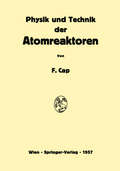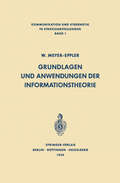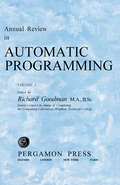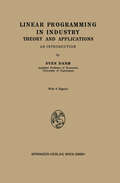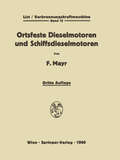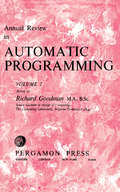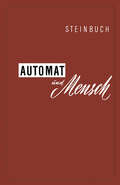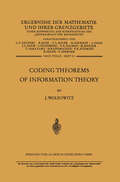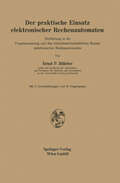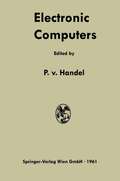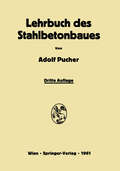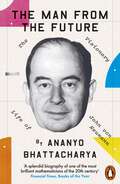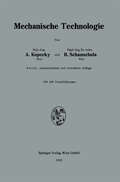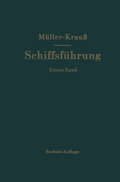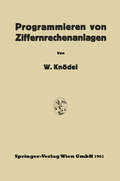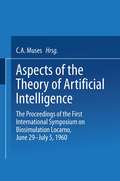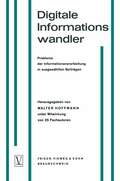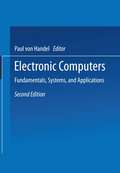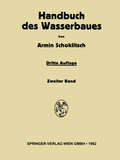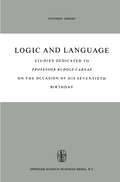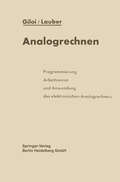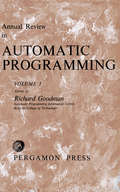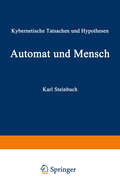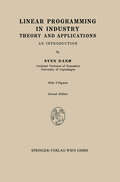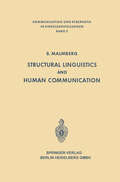- Table View
- List View
Physik und Technik der Atomreaktoren
by Ferdinand CapDieses Buch ist aus Vorlesungen entstanden, die der Verfasser seit dem Studienjahr 1950/51 an der Universität Innsbruck regelmäßig gehalten hat. Es ist nicht nur als Lehrbuch für Studierende, sondern auch als Nachschlagewerk für Fachleute gedacht. Dem Bau eines Reaktors müssen Berechnungen vorangehen, die nicht durch Experimentaluntersuchungen ersetzt werden können. Der Verfasser war daher bestrebt, dem Leser nicht nur ein klares Verständnis aller Vorgänge, sondern auch das notwendige mathematische Rüstzeug zu vermitteln. Gewisse physi kalische und mathematische Vorkenntnisse mußten dabei vorausgesetzt werden; diese Voraussetzungen überschreiten jedoch nicht das durchschnittliche Wissen der Studierenden höherer Semester der in Frage kommenden Fachgebiete. Da bisher kein deutschsprachiges Lehrbuch über Kernreaktoren erschienen ist und da keine einheitliche und allgemein anerkannte deutsche Terminologie besteht, stand der Verfasser vor der Wahl, entweder die englischen Fachausdrücke zu übernehmen oder eine eigene deutsche Terminologie zu prägen. Der Verfasser entschied sich zu letzterem; inwieweit dieser Versuch geglückt ist, wird erst die Zukunft zeigen. Da der Stoff sehr umfangreich ist und da der Leser die Probleme der Praxis kennenlernen soll, wurden jedem Paragraphen Übungsbeispiele beigegeben. Für diejenigen Leser, die die Übungsbeispiele nicht durchrechnen wollen, wäre es jedoch empfehlenswert, deren Text zu lesen, da diese Beispiele sehr oft wichtige Ausführungen und Formeln enthalten.
Grundlagen und Anwendungen der Informationstheorie (Communication and Cybernetics #1)
by Werner Meyer-EpplerAnnual Review in Automatic Programming: Papers Read at the Working Conference on Automatic Programming of Digital Computers Held at Brighton, 1–3 April 1959
by Richard GoodmanAnnual Review in Automatic Programming is a collection of papers presented at the Working Conference on Automatic Programming of Digital Computers held in Brighton, UK, on April 1-3, 1959. Contributors focus on developments in automatic programming and cover topics ranging from automatic coding for TREAC to the PEGASUS and MERCURY autocodes, automatic programming of DEUCE, and the philosophy of programming. Business applications of automatic programming are also discussed. This book is comprised of 17 chapters and begins with a review of future trends in automatic programming, focusing on the environment of a computer as well as machine languages and automatic codes. The features of existing automatic programming languages are also described, along with the advantages and disadvantages of such languages. The next chapter presents some of the arguments in favor of standardized notations for programming, mainly with reference to scientific problems. The reader is also introduced to the Mark 5 system of automatic coding for TREAC; assembly, interpretive, and conversion programs for PEGASUS; and application of formula translation to the automatic coding of ordinary differential equations. The final chapter describes a machine designed for the manufacture of accurate models for wind tunnel tests. This monograph will be of interest to computer programmers, computer manufacturers, computer users, and university students.
Linear Programming in Industry: Theory and Applications. An Introduction
by Sven DanoThe present volume is intended to serve a twofold purpose. First, it provides a university text of Linear Programming for students of or operations research interested in the theory of production economics and cost and its practical applications; secondly, it is the author's hope that engineers, business executives, managers, and others responsible for the organization and planning of industrial operations may find the book useful as an introduction to Linear Programming methods and techniques. Despite the different backgrounds of these categories of potential readers, their respective fields overlap to a considerable extent; both are concerned with economic optimization problems, and the use of Linear Programming to problems of production planning is simply applied theory of production. The non-economist reader may, but should not, pass over Chapter IV in which the linear production model is linked up with the economic theory of production. Without being an advanced text, the book aims at covering enough ground to make the reader capable of detecting, formulating, and solving such linear planning problems as he may encounter within his particular field. No heavy demands are made on the reader's mathematical profi ciency; except for the proofs in the Appendix-which may be skipped ü desired-the mathematical exposition is purely elementary, involving only simple linear relations. In the author's experience, the pedagogical advantages of this approach, as compared with the use of matrix algebra, amply justify the sacrilice of mathematical elegance and typographical simplicity, particularly in explaining the simplex method.
Annual Review in Automatic Programming: International Tracts in Computer Science and Technology and Their Application, Vol. 2
by Richard GoodmanAnnual Review in Automatic Programming, Volume 2 is a collection of papers that discusses the controversy about the suitability of COBOL as a common business oriented language, and the development of different common languages for scientific computation. A couple of papers describes the use of the Genie system in numerical calculation and analyzes Mercury autocode in terms of a phrase structure language, such as in the source language, target language, the order structure of ATLAS, and the meta-syntactical language of the assembly program. Other papers explain interference or an "intermediate return" using ALGOL, the National-Elliot 803 Computer, and the MADCAP II. MADCAP II is A version of the automatic programming compiler for MANIAC II. One paper discusses the APT which serves as a common computer language for computational problems. Another paper explains SAKO which can bypass machine language almost entirely in the field of numerical and logical problems, particularly in programs using XYZ and ZAM II. A report of the Working Committee of the British Computer Society Discussion Group No. 5 concludes that COBOL is unnecessarily complex due to its close machine orientation. Computer engineers, computer instructors, programmers, and students of computer science will find the collection highly valuable.
Automat und Mensch: Über menschliche und maschinelle Intelligenz
by Karl SteinbuchDie Fähigkeiten moderner Automaten sprengen die Grenze dessen, was einst für "mechanische" Gebilde als möglich erachtet wurde. Ihre Eigenschaften werden beschrieben in Kategorien, die bisher den Menschen vorbehalten waren, z. B. logische Verknüpfung, Zei chenerkennung, Gedächtnis, Lernen. Der Mensch ist für uns das "unbekannte Wesen" [20. 7]. Unsere Einsicht in die Funktion unseres Denksystems ist gering. Wenn nun plötzlich durch Automaten vergleichbare Eigenschaften erzeugt werden können ("künstliche Intelligenz"), erschließt sich dem for schenden Geist ein neuer Weg zum Verständnis des Menschen: Nämlich über das Verständnis der Automaten. Viele überkommene Vorstellungen müssen revidiert werden. Die Frage ist: Kann man geistige Vorgänge durch Erkenntnisse an Automaten nicht verstehen, teilweise verstehen, ganz verstehen? Die häufig gegebene Antwort, daß die Erkenntnisse der Physik für den einen Teil geistiger Vorgänge zuständig seien, für den anderen je doch nicht, ist meines Erachtens ein schlechter Kompromiß. Man muß zwar zugestehen, daß unsere heutigen Erkenntnisse nicht aus reichen, um alles oder auch nur den überwiegenden Teil zu erklären, man sollte aber keinesfalls die Vermutung akzeptieren, geistige Vorgänge unterhalb einer kritischen Organisationshöhe könne man physikalisch erklären, oberhalb dieser kritischen Organisationshöhe sei jedoch eine "überphysik" zuständig. Solche Sprünge macht die Natur nicht. In diesem Buch werden die Grundbegriffe, die zum Ver ständnis moderner Automaten erforderlich sind, erklärt. In den ersten Kapiteln herrschen deshalb technische Erläuterungen vor. Hierbei ist eine leichtverständliche Darstellung angestrebt. Mathematische Formeln wurden weitgehend vermieden, dagegen sollen Bilder das Wesentliche veranschaulichen.
Coding Theorems of Information Theory: Reihe: Wahrscheinlichkeitstheorie und Mathematische Statistik (Ergebnisse der Mathematik und ihrer Grenzgebiete. 2. Folge #31)
by Jacob WolfowitzThis monograph originated with a course of lectures on information theory which I gave at Cornell University during the academic year 1958-1959. It has no pretensions to exhaustiveness, and, indeed, no pretensions at all. Its purpose is to provide, for mathematicians of some maturity, an easy introduction to the ideas and principal known theorems of a certain body of coding theory. This purpose will be amply achieved if the reader is enabled, through his reading, to read the (sometimes obscurely written) literature and to obtain results of his own. The theory is ob viously in a rapid stage of development; even while this monograph was in manuscript several of its readers obtained important new results. The first chapter is introductory and the subject matter of the monograph is described at the end of the chapter. There does not seem to be a uniquely determined logical order in which the material should be arranged. In determining the final arrangement I tried to obtain an order which makes reading easy and yet is not illogical. I can only hope that the resultant compromises do not earn me the criticism that I failed on both counts. There are a very few instances in the monograph where a stated theorem is proved by a method which is based on a result proved only later.
Der praktische Einsatz elektronischer Rechenautomaten: Einführung in die Programmierung und den betriebswirtschaftlichen Einsatz elektronischer Rechenautomaten
by Ernst P. BilleterDas vorliegende Lehrbuch ist auf Grund einer Vorlesung entstanden, die ich erstmals im Jahre 1958 an der Universität Freiburg (Schweiz) und an der Handelshochschule St. Gallen gehalten hatte. Ihr Inhalt ist dann jeweils dem neuesten Stand der Forschung angepaßt worden, indem es mir möglich war, die Erfahrungen, die ich als wissenschaftlicher Leiter der ersten und zweiten Studienreise nach den USA über Automation (Swiss Automation Tour to the USA) in den Jahren 1959 und 1960 sammeln konnte, zu verwerten. Der Inhalt des Buches richtet sich vor allem an angehende Volks und Betriebswirtschafter sowie an Personen, die sich in der Praxis Pro blemen der Programmierung elektronischer Rechenautomaten gegenüber gestellt sehen. Angesichts der Entwicklung auf dem Gebiete der admini strativen Automation ist es besonders erwünscht, daß sich Volks- und Betriebswirtschafter mit diesen Verfahren vertraut machen, da sie vor allem berufen sind, dem Unternehmer beim Einsatz solcher Geräte in der Unternehmung behilflich zu sein. Ich hoffe, daß diesem Buche eine gute Aufnahme beschieden sein wird, und daß es einem großen Personenkreis ermöglichen wird, das ge steckte Ziel zu erreichen. Freiburg (Schweiz), Ende Dezember 1960.
The Man from the Future: The Visionary Life of John von Neumann
by Ananyo Bhattacharya'A sparkling book, with an intoxicating mix of pen-portraits and grand historical narrative. Above all it fizzes with a dizzying mix of deliciously vital ideas. . . A staggering achievement' Tim HarfordAn exhilarating new biography of John von Neumann: the lost genius who invented our worldThe smartphones in our pockets and computers like brains. The vagaries of game theory and evolutionary biology. Self-replicating moon bases and nuclear weapons. All bear the fingerprints of one remarkable man: John von Neumann.Born in Budapest at the turn of the century, von Neumann is one of the most influential scientists to have ever lived. His colleagues believed he had the fastest brain on the planet - bar none. He was instrumental in the Manhattan Project and helped formulate the bedrock of Cold War geopolitics and modern economic theory. He created the first ever programmable digital computer. He prophesied the potential of nanotechnology and, from his deathbed, expounded on the limits of brains and computers - and how they might be overcome.Taking us on an astonishing journey, Ananyo Bhattacharya explores how a combination of genius and unique historical circumstance allowed a single man to sweep through so many different fields of science, sparking revolutions wherever he went.Insightful and illuminating, The Man from the Future is a thrilling intellectual biography of the visionary thinker who shaped our century.
Mechanische Technologie
by Alfred Kopecky Rudolf SchamschulaDie Technologie ist die Lehre von der Umwandlung der Rohstoffe in Gebrauchsgegenstände. Die mechanische Technologie befaßt sich mit den Änderungen der äußeren Gestalt, die chemische Technologie mit den Änderungen der chemischen Zusammensetzung. Bei der Herstellung der MetaJIe und Kunststoffe, beim Schweißen usw. spielen chemische Vor gänge eine bedeutende Rolle, so daß auf diese im vorliegenden Werk ein gegangen werden mußte. Die Unterteilung des Stoffes erfolgte in drei Abschnitte: Werkstoff kunde, Werkstoffprüfung und Werkstoff verarbeitung. Diese wurde unter teilt in die spanlose Formung (Gießen, Schmieden, Walzen, Ziehen, Stanzen, ... ), die spanabhebende Formung, die in einem besonderen Werk behandelt werden soll, und die verbindenden Arbeitsverfahren (Schweißen, Löten, ... ). Das vorliegende Buch befaßt sich in erster Linie mit den Metallen, widmet jedoch dem Holz, den Kunststoffen, Brennstoffen, elektrischen Isolierstoffen, feuerfesten Baustoffen usf. einige Abschnitte in der Werk stoffkunde. A. Werkstoffkunde I. Die metallischen Werkstoffe 1. Allgemeines a) Die Eigenschaften der metallischen Werkstoffe Die Werkstoffe können grundsätzlich nur aus einem chemischen Ele ment allein bestehen oder aus mehreren chemischen Elementen zusammen gesetzt sein. Im ersten Fall unterscheiden wir Metalle und Nichtmetalle, im zweiten Fall mechanische Gemenge, Lösungen und chemische Ver bindungen. Bei diesen unterscheidet man anorganische und organische Verbindungen. Von letzteren glaubte man, daß sie nur in Lebewesen vor kämen.
Aspects of the Theory of Artificial Intelligence: The Proceedings of the First International Symposium on Biosimulation Locarno, June 29 – July 5, 1960 (pdf)
by Charles Arthur MusésDigitale Informationswandler / Digital Information Processors / Dispositifs traitant des informations numériques: Probleme der Informationsverarbeitung in ausgewählten Beiträgen / Selected Articles on Problems of Information Processing / Une sélection d’articles techniques sur les problèmes concernant le traitement d’informations
by Walter HoffmannLogic and Language: Studies dedicated to Professor Rudolf Carnap on the Occasion of his Seventieth Birthday (Synthese Library #5)
by B. H. Kazemier D. VuysjeAnalogrechnen: Programmierung, Arbeitsweise und Anwendung des elektronischen Analogrechners
by Wolfgang Giloi Rudolf LauberDas Prinzip des analogen Rechnens, das Lösen mathematischer Aufgaben durch Beobachtung physikalischer Modelle mit analogen Gesetzmäßigkeiten, hat im elektronischen Analogrechner seine Vervoll kommnung in Hinsicht auf möglichst große mathematische Exaktheit und Flexibilität in der Anwendung gefunden. Als mit dem Siegeszug des programmgesteuerten Digitalrechners die Sterbestunde der mechanischen Integrieranlagen und der elektrolytischen Tröge anbrach, fehlte es nicht an Stimmen, die auch dem elektronischen Analogrechner, etwa zur gleichen Zeit wie der Digitalrechner entstanden, einen frühen Tod weissagten. Nun, die Entwicklung der letzten Jahre hat diese Prophezeihung widerlegt. Der elektronische Analogrechner hat sich einen festen Platz als Rechenmaschine zur Lösung technischer Aufgaben erworben. Seine Anwendung ist längst nicht mehr auf den klassischen Anwendungsbereich in der Regelungstechnik beschränkt. Aus einem elektronischen Gerät, das nur von Elektrotechnikern zu verstehen und auch zu bedienen war, hat er sich schnell zu einer Rechen maschine entwickelt, die heute auf allen Gebieten der Technik und nicht zuletzt auch zur Behandlung rein mathematischer Aufgaben eingesetzt wird. Das vorliegende Buch ist für den ständig wachsenden Kreis der Benutzer des Analogrechners geschrieben. Das setzt voraus, daß es sich einer Sprache bedient, die allen Disziplinen der Technik gemeinsam ist.
Annual Review in Automatic Programming: International Tracts in Computer Science and Technology and Their Application
by Richard GoodmanAnnual Review in Automatic Programming focuses on the techniques of automatic programming used with digital computers. Topics covered range from the design of machine-independent programming languages to the use of recursive procedures in ALGOL 60. A multi-pass translation scheme for ALGOL 60 is described, along with some commercial source languages. The structure and use of the syntax-directed compiler is also considered.Comprised of 12 chapters, this volume begins with a discussion on the basic ideas involved in the description of a computing process as a program for a computer, expressed in a formal symbolic language such as ALGOL 60. The emphasis is on the information conveyed by the program constituents (semantics), rather than the particular form used (syntax). Subsequent chapters focus on generalized ALGOL; the design of machine-independent programming languages; JOVIAL, a programming language for real-time command systems; and a complete ALGOL translator, expressed in ALGOL itself. A detailed description of the compiler compiler is also presented, together with the Rapidwrite program. The final chapter is devoted to file processing in SEAL (Standard Electronic Accounting Language).This monograph will be of interest to computer programmers.
Linear Programming in Industry: Theory and Applications. An Introduction
by Sven DanoThe present volume is intended to serve a twofold purpose. First, it provides a university text of Linear Programming for students of .economics or operations research interested in the theory of production and cost and its practical applications; secondly, it is the author's hope that engineers, business executives, managers, and others responsible for the organization and planning of industrial operations may find the book useful as an introduction to Linear Programming methods and techniques. Despite the different backgrounds of these categories of potential readerft, their respective fields overlap to a considerable extent; both are concernE:'d with economic optimization problems, and the use of Linear Programming to problems of production planning is simply applied theory of production. The non-economist reader may, but should not, pass over Chapter IV in which the linear production model is linked up with the economic theory of production. Without bE:'ing an advanced text, the book aims at covering enough ground to make the reader capable of detecting, formulating, and solving such linear planning problems as he may encounter within his particular field. No heavy demands are made on the reader's mathematical profi ciency; except for the proofs in the Appendix-which may be skipped if desired-the mathematical exposition is purely elementary, involving only simple linear relations. In the author's experience, the pedagogical advantages of this approach, as compared with the use of matrix algebra, amply justify the sacrifice of mathematical elegance and typographical simplicity, particularly in explaining the simplex method.
